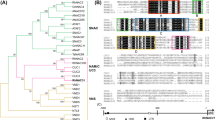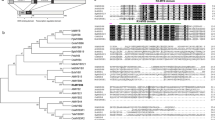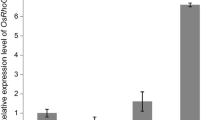Abstract
Key message
Promoter activities of RhACS1 and RhACS2 , two rose genes involved in ethylene biosynthesis, are highly sensitive to various abiotic stresses in an organ-specific manner.
Abstract
Our previous studies indicated that two rose (Rosa hybrida) 1-aminocyclopropane-1-carboxylic acid synthase genes, RhACS1 and RhACS2, play a role in dehydration-induced ethylene production and inhibition of cell expansion in rose petals. Here, both RhACS1 and RhACS2 promoters were analyzed using histochemical staining and glucuronidase synthase (GUS) gene reporter activity assays following their introduction into transgenic Arabidopsis thaliana plants. It was found that the promoter activities of both genes were strong throughout the course of development from young seedlings to mature flowering plants in various organs, including hypocotyls, cotyledons, leaves, roots and lateral roots. RhACS1 promoter activity was induced by drought in both rosette leaves and roots of transgenic A. thaliana lines, but was reduced following a re-hydration treatment. In contrast, RhACS2 promoter activity was decreased by drought in rosette leaves, while its response pattern was similar to that of RhACS1 in roots. A mannitol treatment induced the activity of both the RhACS1 and RhACS2 promoters, indicating that both genes are also regulated by osmotic stress. In addition, RhACS2 appeared to be abscisic acid (ABA)-inducible, while RhACS1 was less sensitive to ABA. Finally, four truncated sequences of the RhACS1 promoter were generated and GUS activity assays demonstrated that deleting a 327 bp region between bp 862 and −535 resulted in a substantial decrease of the promoter activity. Taken together, our results suggest that the RhACS1 and RhACS2 promoters respond to abiotic stresses in a developmentally regulated and spatially specific manner.









Similar content being viewed by others
Abbreviations
- ABA:
-
Abscisic acid
- ACC:
-
1-aminocyclopropane-1-carboxylic acid
- ACS:
-
ACC synthase
- CHX:
-
Cycloheximide
- GUS:
-
β-glucuronidase
- IAA:
-
Indole acetic acid
- MS:
-
Murashige and Skoog
- SAM:
-
S-adenosylmethionine
References
Abeles FB (1966) Auxin stimulation of ethylene evolution. Plant Physiol 41:585–588
Abeles FB, Morgan PW, Saltveit ME (1992) Ethylene in plant biology, 2nd edn. Academic Press Inc., San Diego, CA, pp 182–221
Argueso CT, Hansen M, Kieber JJ (2007) Regulation of ethylene biosynthesis. J Plant Growth Regul 26:92–105
Arteca JM, Arteca RN (1999) A multi-responsive gene encoding 1-aminocyclopropane-1-carboxylate synthase (ACS6) in mature Arabidopsis leaves. Plant Mol Biol 39:209–219
Boller T, Herner RC, Kende H (1979) Assay for and enzymatic formation of an ethylene precursor, 1-aminocyclopropane-1-carboxylic acid in tomatoes. Planta 145:293–303
Bradford M (1976) A rapid and sensitive method for the quantitation of microgram quantities of protein utilizing the principle of protein-dye binding. Anal Biochem 72:248–254
Clough SJ, Bent AF (1998) Floral dip: a simplified method for Agrobacterium-mediated transformation of Arabidopsis thaliana. Plant J 16:735–743
Fluhr R, Mattoo AK (1996) Ethylene: biosynthesis and perception. Crit Rev Plant Sci 15:479–523
Ge L, Liu J, Wong W, Hsiao WLW, Chong K, Xu Z, Yang S, Kung S, Li N (2000) Identification of a novel multiple environmental factor-responsive 1-aminocyclopropane-1-carboxylate synthase gene, NT-ACS2, from tobacco. Plant, Cell Environ 23:1169–1182
Hyodo H, Tanaka K, Yoshisaka J (1985) Induction of 1-aminocyclopropane-1-carboxylic acid synthase in wounded mesocarp tissue of Winter Squash fruit and the effects of ethylene. Plant Cell Physiol 26:161–167
Jefferson RA (1987) Assaying chimeric genes in plants: the GUS gene fusion system. Plant Mol Biol Rep 5:387–405
Johnson PR, Ecker JR (1998) The ethylene gas signal transduction pathway: a molecular perspective. Annu Rev Genet 32:227–254
Jones ML, Woodson WR (1999) Differential expression of three members of the 1-aminocyclopropane-1-carboxylate synthase gene family in carnation. Plant Physiol 119:755–764
Kende H (1993) Ethylene biosynthesis. Ann Rev Plant Physiol Plant Mol Biol 44:283–307
Kim JS, Mizoi J, Yoshida T, Fujita Y, Nakajima J, Ohori T, Todaka D, Nakashima K, Hirayama T, Shinozaki K, Yamaguchi-Shinozaki K (2011) An ABRE promoter sequence is involved in osmotic stress-responsive expression of the DREB2A gene, which encodes a transcription factor regulating drought-inducible genes in Arabidopsis. Plant Cell Physiol 52:2136–2146
Lam E, Chua NH (1989) ASF-2, a factor that binds to the cauliflower mosaic virus 35S promoter and a conserved GATA motif in Cab promoters. Plant Cell 1:1147–1156
Lin Z, Zhong S, Grierson D (2009) Recent advances in ethylene research. J Exp Bot 60:3311–3336
Lindstrom JT, Lei CH, Jones ML, Woodson WR (1999) Accumulation of 1-aminocyclopropane-1-carboxylic acid (ACC) in petunia pollen is associated with expression of a pollen-specific ACC synthase late in development. J Am Soc Hort Sci 124(2):145–151
Liu D, Liu X, Meng Y, Sun C et al (2013) An organ-specific role for ethylene in rose petal expansion during dehydration and rehydration. J Exp Bot 64(8):2333–2344
Lu B, Yu HY, Pei LK, Wong MY, Li N (2002) Prolonged exposure to ethylene stimulates the negative gravitropic responses of Arabidopsis inflorescence stems and hypocotyls. Funct Plant Biol 29:987–997
Ma N, Cai L, Lu W, Tan H, Gao J (2005) Exogenous ethylene influences flower opening of cut roses (Rosa hybrida) by regulating the genes encoding ethylene biosynthesis enzymes. Sci China Ser: Life Sci 48:434–444
Murashige T, Skoog F (1962) A revised medium for rapid growth and bio-assays with tobacco tissue cultures. Physiol Plantarum 15:473–497
Oetiker JH, Olson DC, Shiu OY, Yang S (1997) Differential induction of seven 1-aminocyclopropane-1-carboxylate synthase genes by elicitor in suspension cultures of the tomato (Lycopersicon esculentum). Plant Mol Biol 34:275–286
Peleg Z, Blumwald E (2011) Hormone balance and abiotic stress tolerance in crop plants. Curr Opin Plant Biol 14(3):290–295
Reid MS, Evans RY, Dodge LL et al (1989) Ethylene and silver thiosulphate influence opening of cut rose flowers. J Am Soc Hort Sci 114:436–440
Rodrigues-Pousada RA, De Rycke R, Dedonder A, Van Caeneghem W, Engler G, Van Montagu M, Van Der Straeten D (1993) The Arabidopsis 1-aminocyclopropane-1-carboxylate synthase gene 1 is expressed during early development. Plant Cell 5(8):897–911
Schlagnhaufer CD, Arteca RN, Pell EJ (1997) Sequential expression of two 1-aminocyclopropane-1-carboxylase synthase genes in response to biotic and abiotic stresses in potato (Solanum tuberosum L.) leaves. Plant Mol Biol 35:683–688
Seki M, Umezawa T, Urano K, Shinozaki K (2007) Regulatory metabolic networks in drought stress responses. Curr Opin Plant Biol 10:296–302
Shiu OY, Oetiker JH, Yip WK, Yang S (1998) The promoter of Le-ACS7, an early flooding-induced 1-aminocyclopropane-1- carboxylate synthase gene of the tomato, is tagged by a Sol3 transposon. Proc Natl Acad Sci USA 95:10334–10339
Tang X, Chang L, Wu S, Li P, Liu G, Wang N (2008) Auto-regulation of the promoter activities of Arabidopsis 1-aminocyclopropane-1-carboxylate synthase genes AtACS4, AtACS5, and AtACS7 in response to different plant hormones. Plant Sci 175(1):161–167
Van der Straeten D, Zhou Z, Prinsen E, Van Onckelen HA, Van Montagu MC (2001) A comparative molecular-physiological study of submergence response in lowland and deepwater rice. Plant Physiol 125:955–968
Vieweg MF, Fruhling M, Quandt HJ, Heim U, Baumlein H, Puhler A, Kuster H, Andreas MP (2004) The promoter of the Vicia faba L. leghemoglobin gene VfLb29 is specifically activated in the infected cells of root nodules and in the arbuscule-containing cells of mycorrhizal roots from different legume and non legume plants. Mol Plant Microbe Interact 17:62–69
Wang C, Adams DO (1982) Chilling-induced ethylene production in cucumbers (Cucumis sativus L.). Plant Physiol 69:424–427
Wang KLC, Li H, Ecker JR (2002) Ethylene biosynthesis and signaling networks. Plant Cell 14:S131–S151
Wang N, Shih MC, Li N (2005) The GUS reporter-aided analysis of the promoter activities of Arabidopsis ACC synthase genes AtACS4, AtACS5, and AtACS7 induced by hormones and stresses. J Exp Bot 56(413):909–920
Woltering EJ, Van Doorn WG (1988) Role of ethylene in senescence of petals morphological and taxonomical relationships. J Exp Bot 39:1605–1616
Xue J, Li Y, Tan H, Yang F, Ma N, Gao J (2008) Expression of ethylene biosynthetic and receptor genes in rose floral tissues during ethylene-enhanced flower opening. J Exp Bot 59:2161–2169
Yamagami T, Tsuchisaka A, Yamada K, Haddon WF, Harden LA, Theologis A (2003) Biochemical diversity among the 1-amino-cyclopropane-1-carboxylate synthase isozymes encoded by the Arabidopsis gene family. J Biol Chem 278(49):49102–49112
Yamamoto K, Komatsu Y, Yokoo Y, Furukawa T (1994) Delaying flower opening of cut roses by cis-propenylphosphonic acid. J Jap Soc Hort Sci 63:159–166
Yang SF, Hoffman NE (1984) Ethylene biosynthesis and its regulation in higher plants. Ann Rev Plant Physiol 35:155–189
Yoon IS, Mori H, Kim JH, Kang BG, Imaseki H (1997) VR-ACS6 is an auxin-inducible 1-aminocyclopropane-1-carboxylate acid synthase gene in mungbean (Vigna radiata). Plant Cell Physiol 38:217–224
Yu YB, Yang SF (1980) Biosynthesis of wound ethylene. Plant Physiol 66:281–285
Yu Y, Adams DO, Yang S (1979) 1-Aminocyclopropane-1-carboxylate synthase, a key enzyme in ethylene biosynthesis tomatoes. Arch Biochem Biophys 198:280–286
Yu J, Hu S, Wang J et al (2002) A draft sequence of the rice genome (Oryza sativa L. ssp indica). Science 296:79–92
Zhu JK (2002) Salt and drought stress signal transduction in plants. Ann Rev Plant Biol 53:247
Acknowledgments
This work was supported by the National Natural Science Foundation of China, Grant 31372095 and Grant 31130048, and the 948 project (2011-G17) of the Ministry of Agriculture. We thank PlantScribe (www.plantscribe.com) for carefully editing this manuscript.
Conflict of interest
All the authors declared that they have no conflict of interest.
Author information
Authors and Affiliations
Corresponding author
Additional information
Communicated by R. Schmidt.
Rights and permissions
About this article
Cite this article
Khan, M.A., Meng, Y., Liu, D. et al. Responses of rose RhACS1 and RhACS2 promoters to abiotic stresses in transgenic Arabidopsis thaliana . Plant Cell Rep 34, 795–804 (2015). https://doi.org/10.1007/s00299-015-1742-8
Received:
Revised:
Accepted:
Published:
Issue Date:
DOI: https://doi.org/10.1007/s00299-015-1742-8




